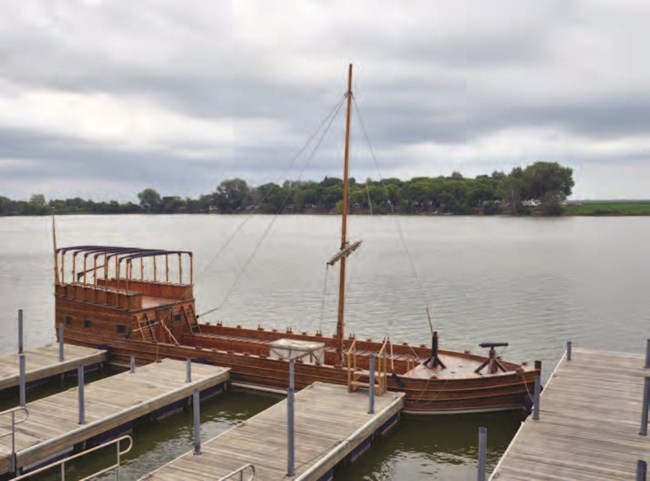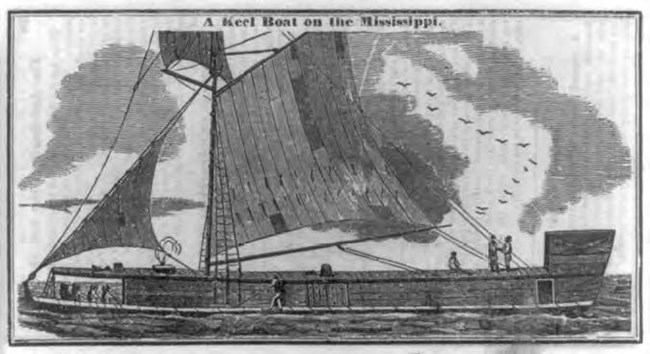Part of a series of articles titled Transportation During the Cherokee Removal 1837 - 1839.
Article
Keelboats: Transportation During the Cherokee Removal 1837 - 1839
"I employed the steamboat Newark to take in tow two keel boats, of 60 tons burden, and 80 feet long each, at $13 per head, to take the detachment from Tuscumbia to Little Rock…[The keelboats] were spacious, well covered, painted, dry, kept constantly clean and well ventilated, by means of side doors, which afforded the Indians the means of sleeping without being exposed to the night air or inclement weather. On the top of each keel were three hearths, which added to the one in the deck of the steamboat, made fire-places which enabled the Indians to cook and eat at regular periods without it being necessary for the boat to stop.”
- Dr. John S. Young, June 25, 183

Image/Courtesy of Library of Congress
Between 1837 and 1839, four Cherokee detachments utilized eight keelboats for their journeys to Indian Territory Keelboats took their name from their construction— long, narrow boats built with a keel providing stability. They typically ranged from 40 to 80 feet long and 8 to 12 feet wide, and came to a point at the bow and stern When fully loaded, the average keelboat drew 2 feet of water, which made it ideal for travel in shallow waters. These versatile boats transported people, food, and various commodities up and down western rivers.
While early keelboats were outftted with a rear cabin, later versions typically had a much larger center cabin, or cargo box, for shelter and storage Keelboats were also equipped with sails and rigging and propelled by wind, rowing, poling, or hand-winching upstream through the rigorous eforts of their crews. Along the perimeter of the gunwales, or upper edge of the sides of the boat, ran a 12- to 18-inch cleated footway for the crew to walk when they were poling the boat Te bow of the boat was outftted with four to twelve seats for oarsmen During the Trail of Tears, however, keelboats were towed, meaning that the space for rowers could be used by passengers.
While no images are known to exist of the keelboats used in the Cherokee removal, period accounts ofer contrasting descriptions of their appearance U S Army Lt Edward Deas, for example, described the initial keelboat used in his April 1838 detachment as “one large Keel with double cabins” that was “commodious.” Deas described the keelboats used in his June 1838 detachment as simply “double deck keels.” Dr Clark Lillybridge, a physician employed to travel with the detachment led by Dr John S Young in 1837, conveyed a more negative assessment, describing the keelboats as a “revolting spectacle ” (See full quote below.)

Image/Courtesy of Library of Congress
"The Boats prepared for the transportation of the Emigrants, are entirely too limited in room and conveniences for the accommodation of the party. The Keel Boats are without Stoves or fires in them, water in the hold, & present to those accustomed as many of the Emigrants are, to many of the comforts of civilized life, rather a revolting spectacle.”
- Dr. Clark Lillybridge, March 13, 1837
The invention of the steamboat and railroads, along with vast improvements in the construction, design, and maintenance of roads and turnpikes, marked the beginning of a transportation revolution in the United States during the early 1800s. The Cherokee removal occurred as this revolution began to unfold. While the Cherokee utilized these transformative modes of transportation during their forced removal, it is important to remember that the majority traveled by foot on roads over rough terrain.
This publication was made possible by the Cooperative Ecosystem Studies Unit (CESU) Task Agreement P18AC01316 with National Trails– National Park Service and the Center for Historic Preservation at Middle Tennessee State University.
Read the Full Report
Last updated: December 21, 2021


